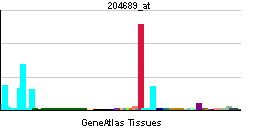HHEX
| Hematopoietically expressed homeobox | |||||||||||||
|---|---|---|---|---|---|---|---|---|---|---|---|---|---|
 PDB rendering based on 2e1o. | |||||||||||||
| |||||||||||||
| Identifiers | |||||||||||||
| Symbols | HHEX ; HEX; HMPH; HOX11L-PEN; PRH; PRHX | ||||||||||||
| External IDs | Template:OMIM5 Template:MGI HomoloGene: 31110 | ||||||||||||
| |||||||||||||
| RNA expression pattern | |||||||||||||
 | |||||||||||||
 | |||||||||||||
| More reference expression data | |||||||||||||
| Orthologs | |||||||||||||
| Template:GNF Ortholog box | |||||||||||||
| Species | Human | Mouse | |||||||||||
| Entrez | n/a | n/a | |||||||||||
| Ensembl | n/a | n/a | |||||||||||
| UniProt | n/a | n/a | |||||||||||
| RefSeq (mRNA) | n/a | n/a | |||||||||||
| RefSeq (protein) | n/a | n/a | |||||||||||
| Location (UCSC) | n/a | n/a | |||||||||||
| PubMed search | n/a | n/a | |||||||||||
Hematopoietically expressed homeobox, also known as HHEX, is a human gene.[1]
This gene encodes a member of the homeobox family of transcription factors, many of which are involved in developmental processes. Expression in specific hematopoietic lineages suggests that this protein may play a role in hematopoietic differentiation.[1]
References
Further reading
- Neidle S, Goodwin GH (1994). "A homology-based molecular model of the proline-rich homeodomain protein Prh, from haematopoietic cells". FEBS Lett. 345 (2–3): 93–8. PMID 7911091.
- Crompton MR, Bartlett TJ, MacGregor AD; et al. (1993). "Identification of a novel vertebrate homeobox gene expressed in haematopoietic cells". Nucleic Acids Res. 20 (21): 5661–7. PMID 1360645.
- Manfioletti G, Gattei V, Buratti E; et al. (1995). "Differential expression of a novel proline-rich homeobox gene (Prh) in human hematolymphopoietic cells". Blood. 85 (5): 1237–45. PMID 7858254.
- Bedford FK, Ashworth A, Enver T, Wiedemann LM (1993). "HEX: a novel homeobox gene expressed during haematopoiesis and conserved between mouse and human". Nucleic Acids Res. 21 (5): 1245–9. PMID 8096636.
- Hromas R, Radich J, Collins S (1993). "PCR cloning of an orphan homeobox gene (PRH) preferentially expressed in myeloid and liver cells". Biochem. Biophys. Res. Commun. 195 (2): 976–83. doi:10.1006/bbrc.1993.2140. PMID 8103988.
- Topcu Z, Mack DL, Hromas RA, Borden KL (2000). "The promyelocytic leukemia protein PML interacts with the proline-rich homeodomain protein PRH: a RING may link hematopoiesis and growth control". Oncogene. 18 (50): 7091–100. doi:10.1038/sj.onc.1203201. PMID 10597310.
- Pellizzari L, D'Elia A, Rustighi A; et al. (2000). "Expression and function of the homeodomain-containing protein Hex in thyroid cells". Nucleic Acids Res. 28 (13): 2503–11. PMID 10871399.
- Schaefer LK, Wang S, Schaefer TS (2001). "Functional interaction of Jun and homeodomain proteins". J. Biol. Chem. 276 (46): 43074–82. doi:10.1074/jbc.M102552200. PMID 11551904.
- Morgutti M, Demori E, Pecile V; et al. (2001). "Genomic organization and chromosome mapping of the human homeobox gene HHEX". Cytogenet. Cell Genet. 94 (1–2): 30–2. PMID 11701950.
- D'Elia AV, Tell G, Russo D; et al. (2002). "Expression and localization of the homeodomain-containing protein HEX in human thyroid tumors". J. Clin. Endocrinol. Metab. 87 (3): 1376–83. PMID 11889211.
- Strausberg RL, Feingold EA, Grouse LH; et al. (2003). "Generation and initial analysis of more than 15,000 full-length human and mouse cDNA sequences". Proc. Natl. Acad. Sci. U.S.A. 99 (26): 16899–903. doi:10.1073/pnas.242603899. PMID 12477932.
- Topisirovic I, Culjkovic B, Cohen N; et al. (2003). "The proline-rich homeodomain protein, PRH, is a tissue-specific inhibitor of eIF4E-dependent cyclin D1 mRNA transport and growth". EMBO J. 22 (3): 689–703. doi:10.1093/emboj/cdg069. PMID 12554669.
- Nakagawa T, Abe M, Yamazaki T; et al. (2003). "HEX acts as a negative regulator of angiogenesis by modulating the expression of angiogenesis-related gene in endothelial cells in vitro". Arterioscler. Thromb. Vasc. Biol. 23 (2): 231–7. PMID 12588764.
- Puppin C, D'Elia AV, Pellizzari L; et al. (2003). "Thyroid-specific transcription factors control Hex promoter activity". Nucleic Acids Res. 31 (7): 1845–52. PMID 12655000.
- Bess KL, Swingler TE, Rivett AJ; et al. (2003). "The transcriptional repressor protein PRH interacts with the proteasome". Biochem. J. 374 (Pt 3): 667–75. doi:10.1042/BJ20030769. PMID 12826010.
- George A, Morse HC, Justice MJ (2003). "The homeobox gene Hex induces T-cell-derived lymphomas when overexpressed in hematopoietic precursor cells". Oncogene. 22 (43): 6764–73. doi:10.1038/sj.onc.1206822. PMID 14555989.
- Minami T, Murakami T, Horiuchi K; et al. (2004). "Interaction between hex and GATA transcription factors in vascular endothelial cells inhibits flk-1/KDR-mediated vascular endothelial growth factor signaling". J. Biol. Chem. 279 (20): 20626–35. doi:10.1074/jbc.M308730200. PMID 15016828.
- Puppin C, Presta I, D'Elia AV; et al. (2004). "Functional interaction among thyroid-specific transcription factors: Pax8 regulates the activity of Hex promoter". Mol. Cell. Endocrinol. 214 (1–2): 117–25. doi:10.1016/j.mce.2003.10.061. PMID 15062550.
- Swingler TE, Bess KL, Yao J; et al. (2004). "The proline-rich homeodomain protein recruits members of the Groucho/Transducin-like enhancer of split protein family to co-repress transcription in hematopoietic cells". J. Biol. Chem. 279 (33): 34938–47. doi:10.1074/jbc.M404488200. PMID 15187083.
External links
- HHEX+protein,+human at the US National Library of Medicine Medical Subject Headings (MeSH)
| This protein-related article is a stub. You can help Wikipedia by expanding it. |
This article incorporates text from the United States National Library of Medicine, which is in the public domain.